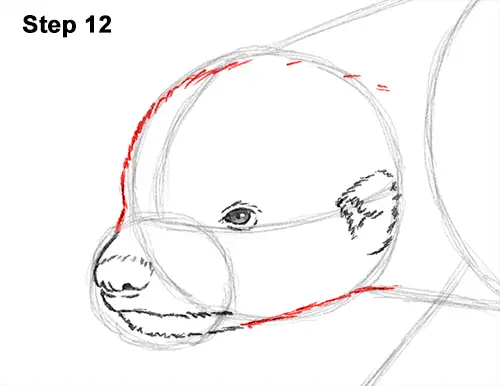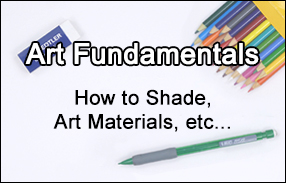
Step 10: Follow the basic path of the small circle as you darken the lines to create the shape of the honey badger's muzzle. Draw a line under the nose that extends to the right toward the head for the mouth. Use quick, short strokes as you draw the line for the mouth to represent fur. Follow the bottom edge of the small circle as you use quick, short strokes to create the chin.

Step 11: Use quick, short strokes to draw the ear inside the head on the right side, where the construction line ends. The honey badger's ear should be small, and the shape should be similar to a backward letter C. Add some strokes wthin the shape for the fur.

Step 12: Use the main circle as a guide to draw the shape of the honey badger's head. Use quick, short strokes as you follow the basic path of the circle to give the head a furry texture. The forehead should be big. The top part of the head should be a bit flatter than the original circle.

Step 13: Use a series of quick, short strokes to create a line on the forehead to represent the fur's color separation. Use strokes of different sizes and set them apart from each other randomly to emphasize the fur. Add a few more quick, short strokes around the eye to add more detail to the fur. Add some strokes to the muzzle too. The honey badger's other eye is hidden at this angle, so don't worry about drawing it.

Step 14: Use the lines on the left side of the body as guides to draw the honey badger's front legs. Lightly sketch the shape of the leg as you follow the path of the guide line. When you get the basic structure of the leg right, darken the lines. Use quick, short strokes that are slightly longer on the right edge of the leg because the fur moves in that direction. At the bottom of the legs, on the left side, draw the claws as curved spike-like shapes. The shape of the claws are also similar to a curved less-than sign (<). Honey badgers have long claws, so don't draw them too small.
Draw the front leg on the other side the same way. Sketch lightly as you follow the guide and darken the lines when you get the shape right. Use quick, short strokes to represent fur. Make the strokes longer on the right edge of the leg because the fur turns that way. The badger is stepping forward, so the claws should point down. Their shape should be similar a curved letter V.







